高考英语非谓语动词(总结改错)
- 格式:docx
- 大小:26.37 KB
- 文档页数:11
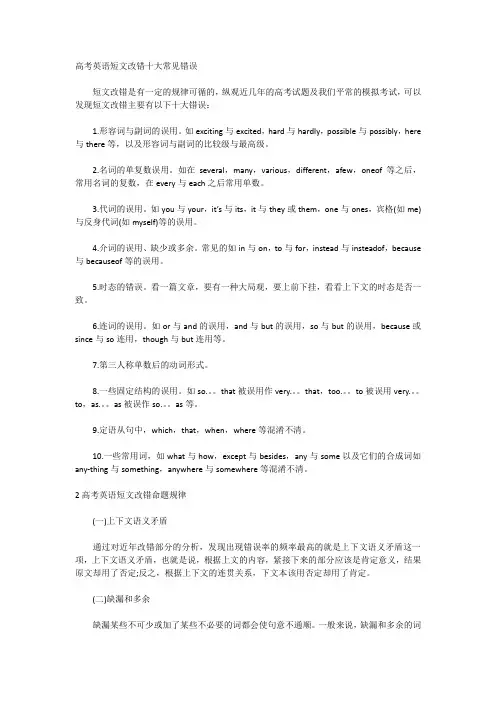
高考英语短文改错十大常见错误短文改错是有一定的规律可循的,纵观近几年的高考试题及我们平常的模拟考试,可以发现短文改错主要有以下十大错误:1.形容词与副词的误用。
如exciting与excited,hard与hardly,possible与possibly,here 与there等,以及形容词与副词的比较级与最高级。
2.名词的单复数误用。
如在several,many,various,different,afew,oneof等之后,常用名词的复数,在every与each之后常用单数。
3.代词的误用。
如you与your,it’s与its,it与they或them,one与ones,宾格(如me)与反身代词(如myself)等的误用。
4.介词的误用、缺少或多余。
常见的如in与on,to与for,instead与insteadof,because 与becauseof等的误用。
5.时态的错误。
看一篇文章,要有一种大局观,要上前下挂,看看上下文的时态是否一致。
6.连词的误用。
如or与and的误用,and与but的误用,so与but的误用,because或since与so连用,though与but连用等。
7.第三人称单数后的动词形式。
8.一些固定结构的误用。
如so.。
that被误用作very.。
that,too.。
to被误用very.。
to,as.。
as被误作so.。
as等。
9.定语从句中,which,that,when,where等混淆不清。
10.一些常用词,如what与how,except与besides,any与some以及它们的合成词如any-thing与something,anywhere与somewhere等混淆不清。
2高考英语短文改错命题规律(一)上下文语义矛盾通过对近年改错部分的分析,发现出现错误率的频率最高的就是上下文语义矛盾这一项,上下文语义矛盾,也就是说,根据上文的内容,紧接下来的部分应该是肯定意义,结果原文却用了否定;反之,根据上下文的连贯关系,下文本该用否定却用了肯定。
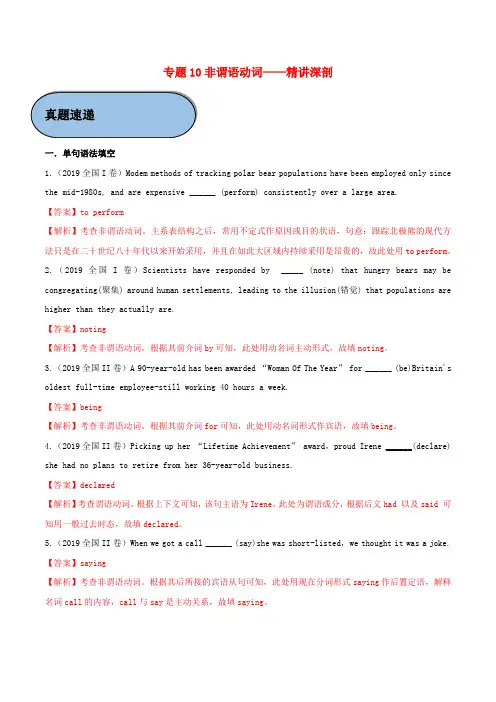
专题10非谓语动词——精讲深剖一.单句语法填空1.(2019全国I卷)Modem methods of tracking polar bear populations have been employed only since the mid-1980s, and are expensive ______ (perform) consistently over a large area.【答案】to perform【解析】考查非谓语动词。
主系表结构之后,常用不定式作原因或目的状语,句意:跟踪北极熊的现代方法只是在二十世纪八十年代以来开始采用,并且在如此大区域内持续采用是昂贵的,故此处用to perform。
2.(2019全国I卷)Scientists have responded by _____ (note) that hungry bears may be congregating(聚集) around human settlements, leading to the illusion(错觉) that populations are higher than they actually are.【答案】noting【解析】考查非谓语动词。
根据其前介词by可知,此处用动名词主动形式,故填noting。
3.(2019全国II卷)A 90-year-old has been awarded “Woman Of The Year” for ______ (be)Britain's oldest full-time employee-still working 40 hours a week.【答案】being【解析】考查非谓语动词。
根据其前介词for可知,此处用动名词形式作宾语,故填being。
4.(2019全国II卷)Picking up her “Lifetime Achievement” award,proud Irene ______(declare) she had no plans to retire from her 36-year-old business.【答案】declared【解析】考查谓语动词。


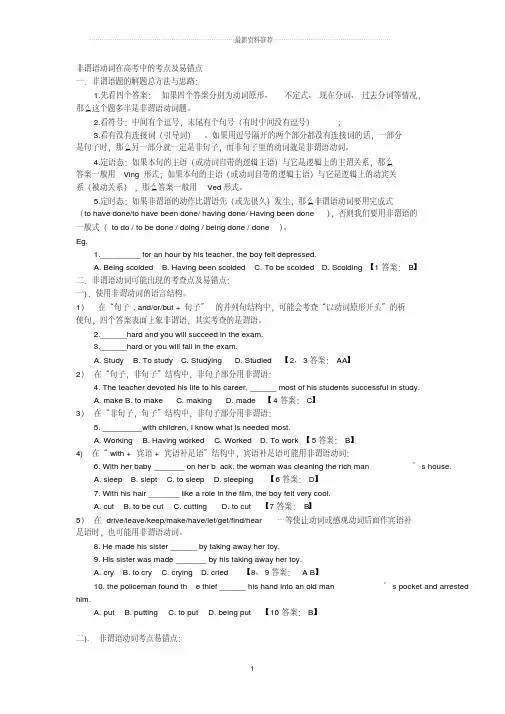
非谓语动词在高考中的考点及易错点一.非谓语题的解题总方法与思路:1.先看四个答案:如果四个答案分别为动词原形、不定式、现在分词、过去分词等情况,那么这个题多半是非谓语动词题。
2.看符号:中间有个逗号,末尾有个句号(有时中间没有逗号);3.看有没有连接词(引导词)。
如果用逗号隔开的两个部分都没有连接词的话,一部分是句子时,那么另一部分就一定是非句子,而非句子里的动词就是非谓语动词。
4.定语态:如果本句的主语(或动词自带的逻辑主语)与它是逻辑上的主谓关系,那么答案一般用Ving形式;如果本句的主语(或动词自带的逻辑主语)与它是逻辑上的动宾关系(被动关系),那么答案一般用Ved形式。
5.定时态:如果非谓语的动作比谓语先(或先很久)发生,那么非谓语动词要用完成式(to have done/to have been done/ having done/ Having been done),否则我们要用非谓语的一般式(to do / to be done / doing / being done / done)。
Eg.1._________ for an hour by his teacher, the boy felt depressed.A. Being scoldedB. Having been scoldedC. To be scoldedD. Scolding 【1答案:B】二.非谓语动词可能出现的考查点及易错点:一).使用非谓动词的语言结构。
1)在“句子, and/or/but +句子”的并列句结构中,可能会考查“以动词原形开头”的祈使句,四个答案表面上象非谓语,其实考查的是谓语。
2.______hard and you will succeed in the exam.3.______hard or you will fail in the exam.A. StudyB. To studyC. StudyingD. Studied 【2、3答案:AA】2)在“句子,非句子”结构中,非句子部分用非谓语:4. The teacher devoted his life to his career, ______ most of his students successful in study.A. makeB. to makeC. makingD. made 【4答案:C】3)在“非句子,句子”结构中,非句子部分用非谓语:5. _________with children, I know what is needed most.A. WorkingB. Having workedC. WorkedD. To work 【5答案:B】4) 在“with + 宾语+ 宾语补足语”结构中,宾语补足语可能用非谓语动词:6. With her baby _______ on her b ack, the woman was cleaning the rich man’s house.A. sleepB. sleptC. to sleepD. sleeping 【6答案:D】7. With his hair _______ like a role in the film, the boy felt very cool.A. cutB. to be cutC. cuttingD. to cut 【7答案:B】5)在drive/leave/keep/make/have/let/get/find/hear…等使让动词或感观动词后面作宾语补足语时,也可能用非谓语动词。
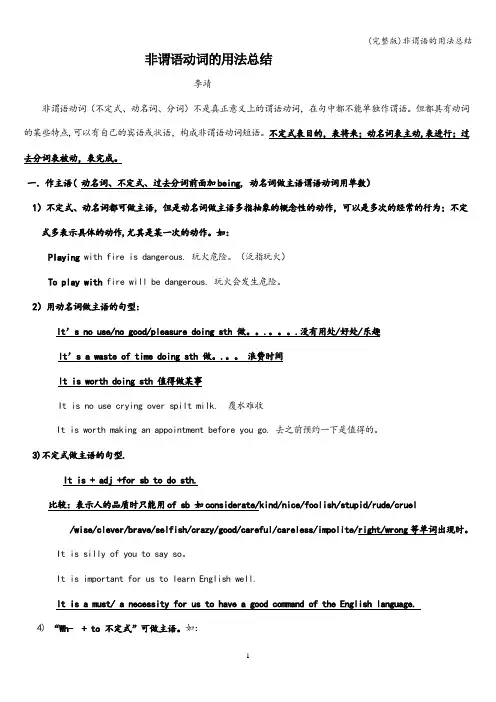
非谓语动词的用法总结李靖非谓语动词(不定式、动名词、分词)不是真正意义上的谓语动词,在句中都不能单独作谓语。
但都具有动词的某些特点,可以有自己的宾语或状语,构成非谓语动词短语。
不定式表目的,表将来;动名词表主动,表进行;过去分词表被动,表完成。
一.作主语( 动名词、不定式、过去分词前面加being, 动名词做主语谓语动词用单数)1)不定式、动名词都可做主语,但是动名词做主语多指抽象的概念性的动作,可以是多次的经常的行为;不定式多表示具体的动作,尤其是某一次的动作。
如:Playing with fire is dangerous. 玩火危险。
(泛指玩火)To play with fire will be dangerous. 玩火会发生危险。
2)用动名词做主语的句型:It’s no use/no good/pleasure doing sth 做。
.。
.没有用处/好处/乐趣It’s a waste of time doing sth 做。
.。
浪费时间It is worth doing sth 值得做某事It is no use crying over spilt milk. 覆水难收It is worth making an appointment before you go. 去之前预约一下是值得的。
3)不定式做主语的句型.It is + adj +for sb to do sth.比较:表示人的品质时只能用of sb 如considerate/kind/nice/foolish/stupid/rude/cruel /wise/clever/brave/selfish/crazy/good/careful/careless/impolite/right/wrong等单词出现时。
It is silly of you to say so。
It is important for us to learn English well.It is a must/ a necessity for us to have a good command of the English language.4) “Wh- + to 不定式”可做主语。
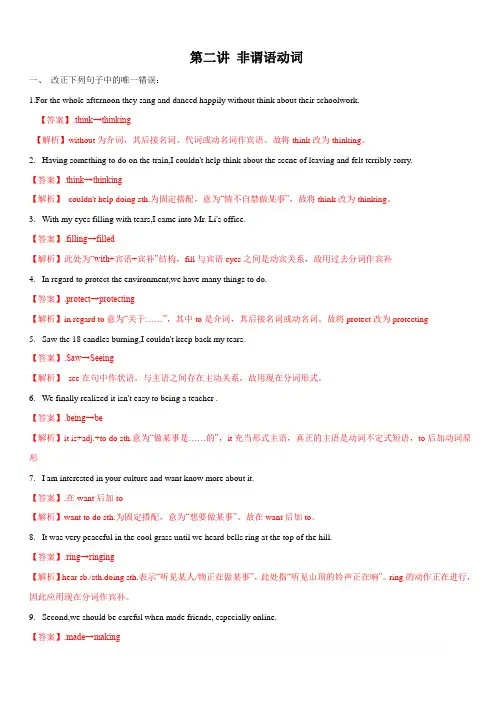
第二讲非谓语动词一、改正下列句子中的唯一错误:1.For the whole afternoon they sang and danced happily without think about their schoolwork.【答案】.think→thinking【解析】without为介词,其后接名词、代词或动名词作宾语。
故将think改为thinking。
2.Having something to do on the train,I couldn't help think about the scene of leaving and felt terribly sorry.【答案】.think→thinking【解析】couldn't help doing sth.为固定搭配,意为“情不自禁做某事”,故将think改为thinking。
3.With my eyes filling with tears,I came into Mr. Li's office.【答案】.filling→filled【解析】此处为“with+宾语+宾补”结构,fill与宾语eyes之间是动宾关系,故用过去分词作宾补4.In regard to protect the environment,we have many things to do.【答案】.protect→protecting【解析】in regard to意为“关于……”,其中to是介词,其后接名词或动名词。
故将protect改为protecting5.Saw the 18 candles burning,I couldn't keep back my tears.【答案】.Saw→Seeing【解析】see在句中作状语,与主语之间存在主动关系,故用现在分词形式。
6.We finally realized it isn't easy to being a teacher .【答案】.being→be【解析】it is+adj.+to do sth.意为“做某事是……的”,it充当形式主语,真正的主语是动词不定式短语,to后加动词原形7.I am interested in your culture and want know more about it.【答案】.在want后加to【解析】want to do sth.为固定搭配,意为“想要做某事”。

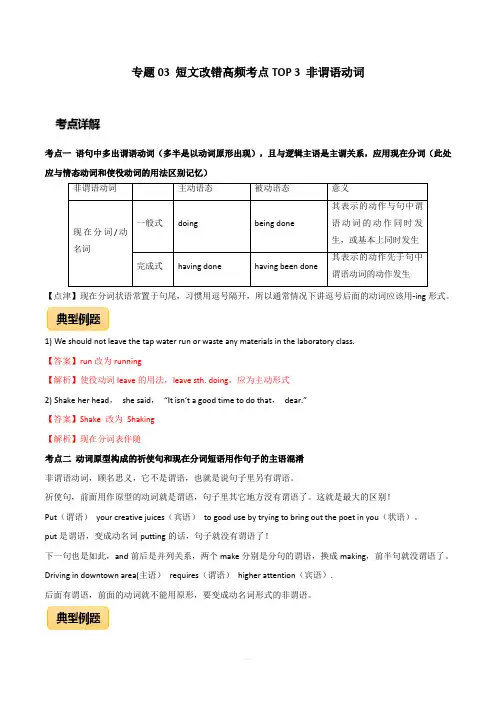
专题03 短文改错高频考点TOP 3 非谓语动词考点一语句中多出谓语动词(多半是以动词原形出现),且与逻辑主语是主谓关系,应用现在分词(此处应与情态动词和使役动词的用法区别记忆)非谓语动词主动语态被动语态意义现在分词/动名词一般式doing being done其表示的动作与句中谓语动词的动作同时发生,或基本上同时发生完成式having done having been done其表示的动作先于句中谓语动词的动作发生【点津】现在分词状语常置于句尾,习惯用逗号隔开,所以通常情况下讲逗号后面的动词应该用-ing形式。
1)We should not leave the tap water run or waste any materials in the laboratory class.【答案】run改为running【解析】使役动词leave的用法,leave sth. doing,应为主动形式2)Shake her head,she said,“It isn‘t a good time to do that,dear.”【答案】Shake 改为Shaking【解析】现在分词表伴随考点二动词原型构成的祈使句和现在分词短语用作句子的主语混淆非谓语动词,顾名思义,它不是谓语,也就是说句子里另有谓语。
祈使句,前面用作原型的动词就是谓语,句子里其它地方没有谓语了。
这就是最大的区别!Put(谓语)your creative juices(宾语)to good use by trying to bring out the poet in you(状语)。
put是谓语,变成动名词putting的话,句子就没有谓语了!下一句也是如此,and前后是并列关系,两个make分别是分句的谓语,换成making,前半句就没谓语了。
Driving in downtown area(主语)requires(谓语)higher attention(宾语).后面有谓语,前面的动词就不能用原形,要变成动名词形式的非谓语。

第七讲非谓语动词一、改正下列句子中的唯一错误:1.For the whole afternoon they sang and danced happily without think about their schoolwork.【答案】.think→thinking【解析】without为介词,其后接名词、代词或动名词作宾语。
故将think改为thinking。
2.Having something to do on the train,I couldn't help think about the scene of leaving and felt terribly sorry.【答案】.think→thinking【解析】couldn't help doing sth.为固定搭配,意为“情不自禁做某事”,故将think改为thinking。
3.With my eyes filling with tears,I came into Mr. Li's office.【答案】.filling→filled【解析】此处为“with+宾语+宾补”结构,fill与宾语eyes之间是动宾关系,故用过去分词作宾补4.In regard to protect the environment,we have many things to do.【答案】.protect→protecting【解析】in regard to意为“关于……”,其中to是介词,其后接名词或动名词。
故将protect改为protecting 5.Saw the 18 candles burning,I couldn't keep back my tears.【答案】.Saw→Seeing【解析】see在句中作状语,与主语之间存在主动关系,故用现在分词形式。
6.We finally realized it isn't easy to being a teacher .【答案】.being→be【解析】it is+adj.+to do sth.意为“做某事是……的”,it充当形式主语,真正的主语是动词不定式短语,to后加动词原形7.I am interested in your culture and want know more about it.【答案】.在want后加to【解析】want to do sth.为固定搭配,意为“想要做某事”。
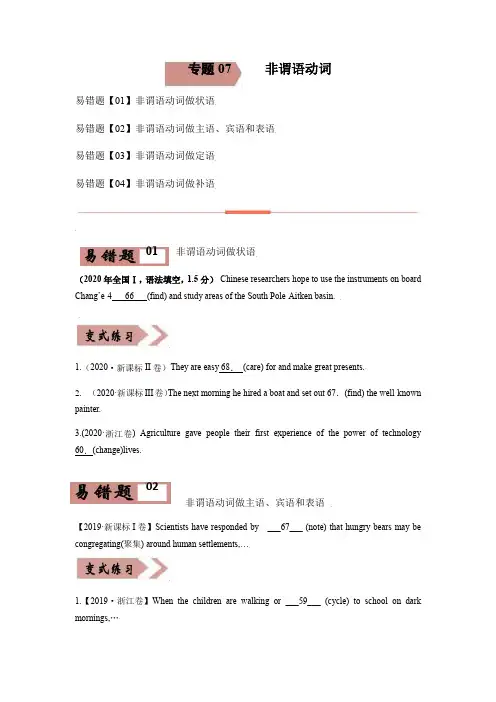
专题07 非谓语动词易错题【01】非谓语动词做状语易错题【02】非谓语动词做主语、宾语和表语易错题【03】非谓语动词做定语易错题【04】非谓语动词做补语01非谓语动词做状语(2020年全国Ⅰ,语法填空,1.5分)Chinese researchers hope to use the instruments on board Chang’e -466 (find) and study areas of the South Pole -Aitken basin.1.(2020·新课标II卷)They are easy 68.(care) for and make great presents.2.(2020·新课标III卷)The next morning he hired a boat and set out 67.(find) the well-known painter.3.(2020·浙江卷) Agriculture gave people their first experience of the power of technology 60.(change)lives.非谓语动词做主语、宾语和表语【2019·新课标I卷】Scientists have responded by ___67___ (note) that hungry bears may be congregating(聚集) around human settlements,…1.【2019·浙江卷】When the children are walking or ___59___ (cycle) to school on dark mornings,…022.【2019·浙江卷】But some students didn't want ___63___ (wear) the uniform.3.(2020·新课标I卷)My mom told me how to preparing it4.【2019·新课标II卷】A 90-year-old has been awarded“Woman Of The Year”for ___61___ (be)Britain's oldest full-time employee-still working 40 hours a week.03非谓语动词做定语(2020·新课标II卷)They represent the earth 63.(come) back to life and best wishes for new beginnings.1.【2019·新课标II卷】Picking up her “Lifetime Achievement” award,proud Irene___declared__(declare) she had no plans ___65___ (retire) from her 36-year-old business.2.【2019·新课标II卷】When we got a call ___68___ (say)she was short-listed,we thought it was ___a__ joke.04非谓语动词做补语(2020·新课标II卷)They make great gifs and you see them many times 65.(decorate) with red envelopes and messages of good fortune.1. (2020·新课标II卷)They make great gifs and you see them many times 65.(decorate) with red envelopes and messages of good fortune.2.(2020·山东卷) As well as looking at exhibits, visitors can play with computer simulations (模拟) and imagine themselves (they) living at a different time in history or 43.(walk)through a rainforest.高考真题在线1.(2021.6新高考1卷语法填空)Though it is the only unnatural thing on your way up the mountain, still it highlights the whole adventure and offers a place where you can sit down to rest your8(ache) legs.2.(2021.6全国甲卷语法填空)It is possible3(walk) or bike the entire 14 kilometers.3.(2021.6全国甲卷语法填空)After4(spend) some time looking at all the defensive equipment at the wall, we decided it was time for some action and what better than to ride on a piece of history!4.(2021.6全国乙卷语法填空)Minimize the impact of7(visit) the place.5.(2021.6全国乙卷语法填空)Activity here range from whale watching to hiking (远足)and accommodations aim10(have) a low impact on the natural environment.6.(2021.6 浙江卷语法填空)Mary's sister, Frances Todd Wallace, often cameover8(plant) flowers in the front yard.7.(2021.1 浙江卷语法填空)In 1985, urban men and women in more than three quarters of the countries7(study) had higher BMIs than men and women in rural areas.8.(2021.1 浙江卷语法填空)This may be due to some disadvantages for people 9 (live) in the countryside, including lower levels of income and education, higher costs of healthy foods, and fewer sports facilities.9.(2020·新课标I卷语法填空)Chinese researchers hope to use the instruments onboard Chang’e-4 66.(find) and study areas of the South Pole-Aitken basin.10.((2020·新课标I卷短文改错))I like eating frying tomatoes with eggs, and I thought it must to be easy to cook.11.(2020·新课标I卷短文改错)My mom told me how to preparing it12. (2020·新课标II卷语法填空)They represent the earth 63.(come) back to life and best wishes for new beginnings.13. (2020·新课标II卷语法填空)They make great gifs and you see them many times 65.(decorate) with red envelopes and messages of good fortune.14. (2020·新课标II卷语法填空)They are easy 68.(care) for and make great presents.15. (2020·新课标III卷语法填空)The next morning he hired a boat and set out 67.(find) the well-known painter.16. (2020·新课标III卷语法填空)And when he saw the mists rising from the river and the soft clouds69.(surround) the mountain tops, he was reduced to tears.17.(2020·山东新高考语法填空) As well as looking at exhibits, visitors can play with computer simulations (模拟) and imagine themselves (they) living at a different time in history or 43.(walk)through a rainforest.18. (2020·浙江卷语法填空) Agriculture gave people their first experience of the power of technology 60.(change)lives.19. (2020·浙江卷语法填空)Later,they learned to work with the seasons (season),planting at the right time and,in dry areas,63.(make)use of annual floods to irrigate(灌溉)their fields.20.【2019·新课标III卷·语法填空】On our way to the house,it was raining ___so__ hard that wecouldn't help wondering how long it would take ___62___ (get)there.高考模拟题在线1.(2022·浙江·高三专题练习)Some of us were confident and eager ________ (take) part in the class activity; others were nervous and anxious.2.(2022·浙江·高三专题练习)If I succeed in ________ (manage) one, I will open more.3.(2022·浙江·高三专题练习)I saw some elderly people ________ (practice) Tai Chi slowly. I stopped and watched their movements closely.4.(2022·浙江·高三专题练习)Larger amounts of caffeine can cause a problem ________ (call) caffeinism.5.(2022·浙江·高三专题练习)________ (learn) to think critically is an important skill today’s children will need for the future.6.(2022·浙江·高三专题练习)Everyone was silent, ________ (wait) to see who would be called upon to read his or her paragraph aloud.7.(2019·河南·南阳中学高三阶段练习)The room __________(measure) 6*6 meters actually houses up to 10 people.8.(2019·河南·南阳中学高三阶段练习)The government has worked out a new regulation__________(aim) at reducing the road accidents.9.(2020·新疆·乌市八中高三阶段练习)Fortunately, he narrowly escaped ___________ (kill) in the car accident the other day.10.(2020·浙江·高三专题练习)It took years of work ________(reduce) the industrial pollutionand clean the water.11.(2020·新疆·乌市八中高三阶段练习)It is those who are willing to give rather than receive that deserve _________ (respect) by people.12.(2020·浙江·高三专题练习)When a new day breaks, the walls have given up their heat and are now cold enough _______ (cool) the house during the hot day;_______ the same time, they warm up again for the night.13.(2022·浙江·高三专题练习)You don’t have to run fast or for long ________ (see) the benefit. 14.(2019·全国·高三专题练习)I prefer____(go) swimming rather than go fishing.15.(2019·全国·高三专题练习)There was much information just waiting ______ (refer) to for your report.16.(2019·全国·高三专题练习)I prefer staying at home to _______ (play) with him outside.17.(2019·全国·高三专题练习)The doctors were having a hard time ____________ (persuade) him to lie down.18.(2019·广东梅州·高三阶段练习)Tsinghua University, ___________(found) in 1911, is one of the best universities in China.19.(2019·广东梅州·高三阶段练习)After __________(graduate) from university, he determined to settle in the countryside.20.(2020·浙江·高三专题练习)Keep________ (hold) your position for a while. It helps develop your strength and flexibility.21.(2022·全国·高三专题练习)The teen's act soon spread quickly, ________ (inspire) kids and adults worldwide to take action.22.(2022·全国·高三专题练习)In richer countries, people are more likely to spend time________ (sit) in offices.23.(2022·全国·高三专题练习)And third, tiger sharks have teeth perfectly ________ (design) for cutting their food, so it is certain that the damage will be disastrous.24.(2022·全国·高三专题练习)The problem of phone addiction (成瘾) has been observed since a few years ago, with experts and psychologists ________ (try) to increase awareness about this problem.25.(2022·全国·高三专题练习)Every year more than a billion animals are killed ________ (make) leather products from their skins.26.(2022·全国·高三专题练习)The Terracotta Army, ________ (build) around 2,200 years ago, was intended to protect Emperor Qin Shi Huang in his afterlife.27.(2022·全国·高三专题练习)He said he became crazy about calligraphy, so he decided________ (establish) a calligraphic museum in Moscow.28.(2022·全国·高三专题练习)Food delivery and takeaway services will stop ________ (use) singleuse plastic straws and cutlery (餐具) nationwide.29.(2021·全国·高三专题练习)I quickly lower myself, ducking my head to avoid ________(look)directly into his eyes so he doesn't feel challenge.30.(2021·全国·高三专题练习)“Things ________(lose) never come again!” I couldn’t help saying to myself.31.(2021·全国·高三专题练习)The teacher came into the classroom, ________(follow) by some students.32.(2021·全国·高三专题练习)The vacation is coming and I have an urge__________(travel).33.(2021·全国·高三专题练习)Students brave enough_________(take) this adventure course will certainly learn a lot of useful skills.34.(2021·全国·高三专题练习)She took the dress out of the package and tried it on,only_________(find) it didn’t fit.35.(2021·全国·高三专题练习)Time_________ (permit), you can pay a visit to some places of interest in Hangzhou.36.(2021·全国·高三专题练习)I was too glad_________ (receive) your gift.37.(2021·全国·高三专题练习)My husband and I take turns________ (do) the dishes every night.38.(2021·全国·高三专题练习)________(examine) once every two years, whether it is a car or a bus, is the rule that all drivers must obey.39.(2021·全国·高三专题练习)As your ________ , I am responsible for ________you inpreparing the experiment.(assistance)40.(2021·全国·高三专题练习)All these voluntary activities are ________ with the Chinese Olympic ________. (associate)41.(2021·全国·高三专题练习)_________ (encourage) to aim high, the boy had another go.42.(2021·河北·衡水市冀州区第一中学高三期中)Not ______ (impress) with the quality of your goods, I will certainly not advise others to buy them.43.(2021·河北·衡水市冀州区第一中学高三期中)Greatly ______ (inspire) by the teacher’s words, I have made up my mind not to give up my goal.44.(2021·河北·衡水市冀州区第一中学高三期中)Having a large family ______ (support), he took up two part time jobs in his spare time.45.(2021·河北·衡水市冀州区第一中学高三期中)He likes ______ (chat) about the things with his friends on the Internet.46.(2021·福建·厦门双十中学高三期中)Touched by their enthusiastic________ (express) of affection, I thanked them again and again.47.(2021·福建·厦门双十中学高三期中)________ (persuade) by his adviser, he entered the competition.48.(2022·浙江·高三专题练习)A 90-year-old has been awarded “Woman Of The Year” for __________(be) Britain’s oldest full-time employee—still working 40 hours a week.49.(2021·福建省福州第一中学高三期中)It is important that we educate ourselves to avoid ______ (fool) when purchasing products.50.(2021·河北石家庄·高三期中)After he retired, the old man did all he could to protect the old temple from ________ (damage).。
专题17 非谓语动词易错点解题方法非谓语动词:顾名思义,非谓语动词就是在英语中不能独立作句子谓语而具有其他语法功能的动词。
近年来高考命题常常通过改变熟悉的句型结构或利用一些“ 貌合神离” 的手段,加大考生辨别非谓语动词的难度。
一句话通常不能有两个或两个以上的谓语动词,除非动词是并列谓语或者分别出现在主从复合或并列句中;一句话也不可能无谓语动词(谓语省略的情况除外)。
这种题,只要辨清谓语和非谓语,答案自然明确。
1. At last, we found ourselves in a pleasant park with trees providing shade and _____down to eat our picnic lunch. (2005上海)A. sittingB. having satC. to sitD. sat【答案】D.【解析】此题大家易受习惯心理影响选择分词,即A或B项,而and实际上作为并列连词并列的是found及sat两个动作,而非并列providing与sitting. 答案:D.这是谓语动词。
2. Prices of daily goods _____ through a computer can be lower than store prices.A. are boughtB. boughtC. have been boughtD. buying【答案】B.【解析】此题学生最易错选的答案为A或C。
依据上面陈述,填入A或C句子都有两个谓语动词,而此处两个动词并非并列谓语,也不是分别出现在主从句中,故答案有误。
该题正确答案为B,bought through a computer为一过去分词短语作后置定语,句中只有一个谓语can be lower than。
当然此题如改为Prices of daily goods which have been bought through…也是正确的,因为这一动作出现在从句中。
非谓语动词总结(高考完整版)一、非谓语动词的含义非谓语动词首先是一种动词形式,其次是这种动词形式不能做谓语,综合这两点,我们将其叫做非谓语动词。
老师进来时,她假装正在读书。
④完成时:to have done(表示主动和完成)eg: The thief is said to have escaped.据说小偷已经逃跑了。
⑤完成被动式:to have been done(表示被动和完成)eg:The thief is said to have been arrested.据说小偷已经被抓住了。
⑥完成进行式:to have been doing (表示主动和完成进行)eg: She is said to have been working in the factory over the last 20 years.据说在过去的20年里,她一直在这家工厂工作。
(2)动名词①基本形式:doing (表示主动)eg: Travelling in space by ordinary people will be common in the future.在未来,普通人在太空旅行将会是普遍的事情。
②被动式:being done(表示被动)eg: Freddy and his band could go nowhere without being followed by their fans.弗雷迪和他的乐队到哪里都被他们的粉丝跟着。
③完成式:having done(表示主动和完成)eg: I have no idea of his having done such a thing against you.我不知道他做过这样一件违背你的事情。
④完成被动式:having been done(表示被动和完成)eg: Many customers complain of having been given short weight at that shop.很多顾客抱怨在那家商店被缺斤少两过。
全国高考二卷语法填空及短文改错分类复习资料系列-- 一非谓语动词2014—2018高考语法填空题及改错分类汇编及近期错题集(一).2014--2018全国卷语法填空非谓语动词考查(共28个)2018(I)1) You don’t have to run fast or for long _____________(see) the benefit.2) You may drink, smoke, be overweight and still reduce your risk of _________(die) early by running.2018(II)1) The government encourages farmers to grow corn instead of rice _______(improve) water quality.2) China’s approach to protecting its environment while ___________(feed) its citizens…2018(III)1)I quickly lower myself, ducking my head to avoid ___________(look) directly into his eyes so he doesn’t feel ______________(challenge).2) Once his message was delivered, he allowed me ___________( stay) and watch.2017(I)1)Fat and salt are very important parts of a diet. They are required _____________ (process) the food that we eat, to recover from injury and for several other bodily functions.2) …by ____________(eat) more fast food people will get more salt and fat than theyneed in their diet.2017(II)1) This included digging up the road, ______________( lay) the track and then building a strong roof over the top.2017(III)1) But unlike her school friends,16-year-old Sarah is not spending half-term _______(rest).2) But Sarah, who has taken part in shows along with top models, wants ___________( prove) that she has brains as well as beauty.2016(I)1) …I was the first Western TV reporter ____________(permit) to film a special unit…2) My ambassadorial duties will include _____________( introduce) British visitors to the 120-plus pandas…2016(II)…you’ll be less likely ___________(bring) your work home.2016(III)1) Skilled workers also combine various hardwoods and metal ___________(create) special designs.2) People probably cooked their food in large pots,_________( use) twigs (树枝) to remove it.2015(I)1) A study of travelers ____________(conduct) by the website Trip Advisor names Yangshuo as one of the top 10 destinations in the world.2) Abercrombie & Kent, a travel company in Hong Kong, says it regularly arranges quick getaways here for people __________ (live) in Shanghai and Hong Kong.2015(II)1)The adobe dwellings(土坯房) ________(build) by the Pueblo Indians of the American Southwest are admired by even the most modern of architects and engineers.2)In addition to their simple beauty, what makes the adobe dwellings admirable is their ability to “air condition”a house without ________(use)electric equipment.3)When a new day breaks, the walls have given up their heat and are now cold enough .________ (cool) the house during the hot day;.2014(I)1) It took years of work ___________( reduce) the industrial pollution…2) While there are _____________(amaze) stories of instant transformation…2014(II)1) One morning, I was waiting at the bus stop, worried about________(be) late for school.2) There were many people waiting at the bus stop, and some of them looked very anxious and _______________(disappoint).3) I heard a passenger behind me shouting to the driver, but he refused _______(stop) until we reached the next stop.4) Still, the boy kept __________(ride).已考查的语法项目:动词-ing作定语2动词-ed作定语3动词-ing作状语3动词不定式作状语5动词不定式作主语1动词-ing作动词宾语3动词-ing作介词宾语4动词不定式作宾语2动词不定式作宾补、主补2动词-ed作表语2未考查但《课程标准》作要求的语法项目:动词-ing作主语Laughing at others is impolite.动词-ing作补语You can’t imagine him treating his mother like that.动词-ed作状语Invited to the party, he felt very honored.动词不定式作定语Is this the best way to help him?动词不定式作表语My job is to help the patient.(二)短文改错近四年高考非谓语动词考查(共8个)2018 (Ⅰ)My grandpa said last summer they earned quite a lot by sell the fish.2018 (Ⅱ)As a kid, I loved to watch cartoons, but no matter how many times I asked to watching them, my parents would not to let me.2018(Ⅲ)Everyone was silent, wait to see who would be called upon to read his or her paragraph aloud.2017(Ⅰ)The instructor kept repeating the word, “Speed up!” “Slow down!” “Turning left!”2017 (Ⅱ)In their spare time, they are interesting in planting vegetables in their garden,……2016(Ⅱ) We can choose between staying at home and take a trip.2016(Ⅲ) I showed them I was independent by wear strange clothes.2015(Ⅱ) After looks at the toy for some time, he turned around and found that his parents were missing.(三)非谓语动词错题集:1.More and more people are learning to surf the Internet, _________(take) advantage of the convenience and efficiency benefits.2.A great number of students __________ (question) said they were forced to practise the piano.改错:After class, many students being interviewed spoke highly of her.3.There _________(be) a lack of money, we had to put off building this special school.4.If you choose to home-school your child, there is no one else for you _________(blame) if your child does poorly.5.The younger generation in particular are ready __________ (embrace) the electric revolution.6.Bur over time, he grew increasingly _________ (annoy) that he had no place to store his board once he arrived.* When I talk with some of my friends, they talk as playing, which is really an ________(annoy).7.The world-known Silk Road across the Eurasian Continent is a friendship bridge _______(link) the European and Asian people.8._____________ (suffer) from cancer made his father painful and in low spirits.9.On the first day, I was so nervous that I felt my heart __________(beat) widely.)10.Scientists from the university of York, UK find that chimps don’t appreciate _________(listen) to music, despite their DNA ___________(be)96 to 98 percent similar to that of humans.ter that day came a call ____________(say) my father was in hospital.12.Now my website and Taobao store _________(connect) foreigners with China are like bridges.13.And now with Meghen Markle about ________(become) a new member, the family is thrilled.14.Instead of having a travel agency ___________(arrange) our transportation and accommodations we booked the train tickets and hotel rooms on the Internet by ourselves.15.Both Lancashire and London claim to be the first ___________(invent) this famous meal. (四)非谓语动词语篇配套专练配套练习一:2017年浙江卷语法填空改编Last October, while 1.__________(tend) her garden in Mora, Sweden, Lena Pahlsson pulled out a handful of small carrots and was about 2.__________( throw) them away. But something made her 3._________(look) closer, and she noticed a shining object. Yes, there beneath the leafy top of one tiny carrot was her longlost wedding ring.Pahlsson screamed so loudly that her daughter came 4__________(run) from the house. “She thought I had hurt myself,” says Pahlsson.Sixteen years earlier, Pahlsson had removed the diamond ring 5.________ (cook) a meal. When she wanted 6.___________( put )the ring back on later, it was gone. She suspected that one of her three daughters—then ten, eight, and six—had picked it up, but the girls said they hadn't. Pahlsson and her husband searched the kitchen, 7.____________(check) every corner, but turned up nothing. “I gave up hope of 8._________(find) my ring again,” she says. She never replaced it.Pahlsson and her husband now think the ring probably got 9.________ (sweep) into a pile of kitchen rubbish and was spread over the garden, where it remained until the carrot's leafy top accidentally sprouted (生长) through it. For Pahlsson, its return was a wonder.配套练习二:2016·四川卷语法填空改编The giant panda is loved by people throughout the world.Chinese scientists recently had a chance 1. __________(study) a wild female panda with a newborn baby.She was a very caring mother.For 25 days,she never left her baby, not even to find something 2. __________ (eat)! She would not let any other pandas 3. ____________(come) near. She licked the baby constantly 4. ____________( keep) it clean.Any smell might attract natural enemies that would try 5.__________( eat) the little panda.The mother held the baby in her front paws much the way a human does. If it cried,she rocked it back and forth and gave it little 6. __________(comfort) pats,The mother continued 7. ____________(care) for the young panda for more than two years.By that time,the panda no longer needed its mother for food. However,it stayed with her and learned about the ways of the forest.Then,after two and a half years,the mother drove the young panda away.It was time for her 8. ___________( have) a new baby, and it was also time for the young panda 9. ___________( be) independent.2014—2018高考语法填空题及改错分类汇编及近期错题集非谓语动词练习答案:(一)2014--2018全国卷语法填空2018(I)1)to see 2) dying2018(II)1) to improve 2) feeding2018(III)1) looking / challenged 2) to stay2017(I)1) to process 2) eating2017(II)laying2017(III)1) resting 2) to prove2016(I)1) permitted 2) introducing2016(II)to bring2016(III)1) to create 2) using2015(I)1) conducted 2) living2015(II)1) built 2) using 3) to cool2014(I ) 1) to reduce 2) amazing2014(II)1) being 2) disappointed 3) to stop 4) riding (二)短文改错近四年高考非谓语动词考查2018 (Ⅰ)sell -- selling2018(II)watching -- watch 去掉not与let之间的to 2018(III)wait --waiting2017(I)turning -- turn2017(II)interesting -- interested2016(II)take -- taking2016(III)wear -- wearing2015(II)looks -- looking三、非谓语动词错题集:1. taking2. questioned / 删除being3. being4. to blame5. to embrace6. annoyed / annoyance7. linking8. Suffering9. beating 10. listening11. saying 12. connecting 13. to become 14. arrange 15. to invent四非谓语动词语篇配套专练配套练习一1. tending 2. to throw 3. look 4. running 5. to cook 6. to put7.checking 8. finding 9. swept配套练习二1. to study 2. to eat 3. come 4. to keep 5. to eat 6. comforting 7 . to care/ caring 8. to have 9. to be。
1.当名词被the first ,the last等序数词以及the only ,形容词最高级修饰时,常用不定式作定语,而不管动作是否已完成.He is the only person to know the truth.She is always the first to come and the last to leave.2.被修饰词是抽象名词时,常用不定式作定语:ability,chance,idea,hope,wish,fact,excuse,promise,attempt,way等。
And the best way to strengthen willpower is to make it into a habit.The ability to express an idea is as important as the idea itself.3.主动形式表被动意义的不定式。
主语+be +adj. +to doThe question is very difficult to answer.The armchair is comfortable to sit in .The book is hard to understand.这类词有:easy,difficult,hard,cheap,expensive,fit,comfortable,heavy,good,important,impossible,dangero us,surprised,astonished,delighted,disappointed等,表示主语特征、性质或说明产生这种情感的原因。
4.独立主格结构作状语Weather permitting, we are going to visit you tomorrow.Time permitting (=If time permits), I shall stay here for another two days.The test finished, we began our holiday.Everything done( =After everything was done) , they went home.Mother being ill in bed (=Because Mother was ill in bed), he couldn’t go to work.He came out of the library, a large book under his arm.5.表示感官的动词1感2听,5看feel / hear , listen to / see, watch, notice, observe, look atI heard her sing an English song.I heard her singing an English song when I passed her room.I see him beaten by those bad boys.6. 4个使役动词: have,make,let,get+宾语+宾补(非谓语动词)※ make/let +宾语+ do sth 迫使某人做某事,被动语态为be made to do sth He made me laugh.I was made to laugh by himLet’s go there , shall we ?※ make /let +宾语+done (动词过去分词)(使某事被做)He couldn't make himself heard above the noise of the traffic.Let he clothes washed.※ have +宾语+do sthHe had her go there.※ have+宾语+doing sth 表示动作的执行者为宾语,但是动词必须是持续性动词/延续性动词,后面常接一个时间段He had her standing in the rain for two hoursHe had us laughing all through lunch.※ have +宾语+done 表示叫,让,请别人做某事或遭遇不幸事件I will have my bike repaired this afternoonHe had his wallet stolen at the railway station.He had his pocket picked.※ get +宾语+to do sthHe got his brother to help him.※get +宾语+doing sthHe got his bike running very fast※ get +宾语+doneHe got the car started7.with 的复合结构“With + 复合结构”又称为“with结构”,在句中表状态或说明背景情况,常做伴随,方式,原因,条件等状语。
高考英语短文改错动词的非谓语形式错误单选题30题1. The teacher asked the students ______ too much time playing computer games.A. not to spendB. to not spendC. don't spendD. not spend答案:A。
本题考查动词不定式的否定形式。
“ask sb. not to do sth.”表示“要求某人不要做某事”,动词不定式的否定形式是在“to”前加“not”,所以A 选项正确。
B 选项“to not spend”形式错误;C 选项“don't spend”是谓语形式,不符合此处用法;D 选项“not spend”缺少“to”,结构不正确。
2. It's important for us ______ English well.A. to learnB. learningC. learnD. learned答案:A。
“It's + 形容词+ for sb. to do sth.”是固定句型,表示“对某人来说做某事是……的”,此处需要用动词不定式,A 选项正确。
B 选项“learning”是动名词形式;C 选项“learn”是动词原形;D 选项“learned”是过去式或过去分词,均不符合句型要求。
3. My mother decided ______ a new dress for me.A. buyB. to buyC. buyingD. bought答案:B。
“decide to do sth.”表示“决定做某事”,要用动词不定式,B 选项正确。
A 选项“buy”是动词原形;C 选项“buying”是动名词形式;D 选项“bought”是过去式,均不符合“decide”的用法。
4. The doctor advised him ______ any more.A. not to smokeB. to not smokeC. don't smokeD. not smoke答案:A。
扶弱资料(六)非谓语动词所谓非谓语动词,就是指它们不能在句子中单独作谓语。
但它们又具有动词的特征,即可以有宾语(如果是及物动词的话)、可以有时态和语态的变化、可以有自己的逻辑主语。
同时,它们又具有名词的某些特征,即它们可以作主语、表语、宾语、定语和状语。
一、动词不定式:动词不定式(时态与语态):1. 作主语:To say something is one thing, to do it is another.2. 作表语: My suggestion is to carry out the plan immediately.[注]:在let, make, see, notice, hear等动词后面,作宾补的不定式均省去to. 如: He made a face and made everybody___________(laugh).但是,在被动语态中,作主语补足语的不定式则要加上to.5. 作定语: He used to have a lot of meeting to attend.[注]:当出现the first / second / last / only /best时,常跟不定式作定语He was the first man _____________ (get) to school this morning.6. 不定式作状语: To see what would happen, we stayed there.二、分词(现在分词和过去分词)(一)V-ing 形式(时态与语态):1.___________ (be) poor, he couldn’t go to school.2.We are interested in _____________ ( play) chess.3.The question _____________________ (discuss) now is important.4.The boy was afraid of ____________________ (leave) alone at home.5.____________________ (work) in the country for three years, he knew how to grow vegetables.注:现在分词的完成式表示分词的动作发生在谓语动作之前(二)过去分词(只有一种时态与语态)规则的:V-ed ;不规则的(记不规则动词表)1. The boy went home with his homework _______________ (finish).2. ___________ (see) from the top, the stadium looks like a bird nest.现在分词和过去分词在语态和时间方面有较大区别:现在分词表示的意义是主动的,进行的:the girl gathering flowers(正在采花的女孩)过去分词表示的意义是被动的,完成的:the flowers gathered this morning (早晨采的花)1. 作表语: The news is very exciting. / They are very excited at the news.2. 作定语: Don’t d isturb the sleeping child. / The arrested thief will be sentenced soon.3. 作宾补: He likes to sit on the beach and watch the seagulls flying. / The work left everyone exhausted.[注]:有些动词如see, hear, feel, notice, watch等既可跟现在分词,也可跟不带to的不定式作复合宾语。
它们的区别在于:现在分词着重说明动作正在发生;不定式着重说明动作的全过程I saw the boys climbing the wall. 我看见孩子在爬墙。
I saw the boys climb the wall. 我看见孩子爬墙了。
4. 作状语: They stood there waiting for the busHearing the knock on the door, they stopped talking.Asked to work overtime that evening, I missed a wonderful film.Compare:_______________ (follow) the old man, we went upstairs2. ________________ (follow) by the old man, we went upstairs.三、动名词(V-ing)1.作主语和表语动名词做主语往往表示经常性、习惯性的动作, 在口语中也可以表示具体的动作。
如:Seeing is believing. / My hobby is collecting stamps.[注]:在“It is no use (good)”等习惯表达法中,常用形式主语“it”It is no use quarreling with her. / Is it worthwhile trying again?作宾语在allow, advise, forbid, permit后直接跟动名词作宾语,如果有名词或代词作宾语,则构成“allow/advise/forbid/permit +名词/代词+不定式(宾语补足语)”之形式。
如:We don't allow_______________ (smoke) here.We don't allow anybody ________________ (smoke) here3. 作介词宾语Have you got used to working on the night shift(值班)?Children are fond of reading detective stories.[注]某些习惯用法中,常省略介词,仅保留动名词He is busy (in) preparing a report.They spent a lot of time (in) making preparation.We had great difficulty / trouble (in) finding his house.非谓语动词需要注意的几个问题:(一)、不定式的逻辑主语一般的结构为for+名词+不定式,如:It is difficult for a foreigner to learn Chinese. I found it impossible _____ him to do the job alone.但在表示人物性格,特征等的形容词后kind, brave, careful, clever, foolish, honest, kind, polite, rude, stupid, wise,常用of引出不定式的逻辑主语,如:It was wise of him to do that. It was very brave ________ him to catch the thief.(二)、不定式的主动式还是被动式作定语时,当句中出现的名词或代词是不定式动作的执行者时,用主动式I have a meeting to attend. The teacher gave John a book to read,若不定式动作执行者不是上述情况,而是其他人,用被动态:Here are the clothes to be washed(三)、有些动词虽然既可跟不定式又可跟动名词作宾语,但意义差别较大如;a) remember to do (记住要做某事), remember doing(记得曾做过某事)b) forget to do (忘记要做某事), forget doing (忘记曾做过某事)c) regret to do (因要做某事感到不安), regret doing(因做了某事感到后悔)(四)、分词做表语有两种情况,一种是现在分词做表语,一种是过去分词做表语,这两者区别是考试中经常考到的地方。
一般来说,凡表示“令人……的”都是-ing形式,凡是表示“感到……”都用-ed形式。
这类词常见的有:interesting令人感兴趣的--interested感到有趣的;exciting令人激动的--excited感到激动的delighting令人高兴的--delighted感到高兴的;disappointing令人失望的--disappointed感到失望的(五)、admit, advise, avoid, can't help, consider, delay, deny, escape, enjoy, finish, feel like, imagine, mind, practise, risk, suggest等动词以及所有带介词的短语动词后面只能跟动名词做宾语。
The boy was lucky enough to escape being punished.(六)、look forward to, pay attention to, stick to, devote … to, make contributions to, get/be used to, object to中的to是介词,因而其后接动名词做宾语,不要误用动词不定式。
(1) I'm looking forward to seeing you again.(2) Mr. Reed made up his mind to devote all he had to setting up some schools for poor children.(七)、主动形式表示被动意义动词want, need, require后作宾语的动名词的主动形式。
这时句中的动名词与句子的主语有逻辑上的动宾关系。
例:The TV set wants ( / needs / requires) fixing.= The TV set wants ( / needs / requires) to be fixed.②形容词worth后接的v -ing的主动形式。
例:The film is worth seeing.③某些作表语的形容词(如easy, difficult, hard等)后接的不定式主动形式。